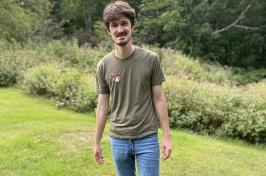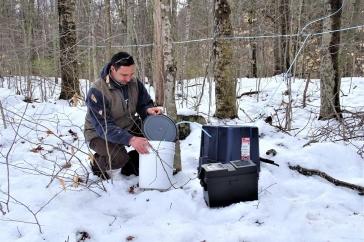New Hampshire’s North Country, which stretches north from Lake Winnipesaukee to the Canadian border and encompasses one-third of the state, plays an important role in the state’s economy and culture. In this sparsely populated region, you’ll find many of the distinctive landscapes associated with the Granite State: scenic highways and secondary roads weaving through the White Mountains, plentiful lakes and streams, and vast forests that transform into kaleidoscopes of color each autumn.
The North Country has undergone significant changes in recent decades. Tourism and recreation have flourished, increasing economic diversity and presenting new opportunities. And COLSA researchers are investigating sustainable ways to manage the natural resources that support the prosperity of the region’s communities in the face of climatic uncertainties.
Related Stats
-
~3k–4k — Current New Hampshire moose population, down from 6k–7k in 1990s.
-
$115M — Annual value of New Hampshire’s moose-watching tourism.
Supporting Moose Conservation: Moose Sighting and Sighing
Location(s): Jericho Mountain State Park, Milan Hill State Park
Moose are an important part of the region’s ecosystem, and their presence drives North Country tourism, but they’ve been hard hit by parasites, particularly the winter tick, in recent years. Assistant Professor Rem Moll is using camera traps and thermal imaging drones to gather data on the moose population. With this information, Moll and his colleagues will study the animals’ responses to different habitats and the impact on them of human activity and infrastructure. Assistant Professor Laura Kloepper is investigating moose vocalizations and how they differ by sex and age. Moll and Kloepper’s work will help better understand and monitor North Country moose and direct conservation planning for one of North America’s largest land mammals.
Related Stat
Forest-Building Fungi
Location(s): Second College Grant, Coös County
Logging and timber production contribute significantly to the North Country’s economy. Responding to a greater need for sustainable forest management, Associate Professor Rebecca Rowe and Professor Serita Frey recently showed how fungal spores are dispersed by wind and small rodents following timber harvests and other forest disturbances, and that the two methods work in tandem to disperse different fungal species critical to establishing and regrowing new forest.
Related Stats
-
Estimated $4 billion in economic damage (nationally) by southern pine beetle outbreaks since 1973.
-
99% — Mortality rate of ash trees infected by emerald ash borer beetles.
-
25M — Number of New Hampshire’s ash trees that are at risk — about 6% of the area’s northern hardwood forest.
Invasive Impacts
Location(s): Bartlett Experimental Forest
Beech bark disease, beech leaf disease and emerald ash borer, as well as insects native to the southern U.S., are damaging New Hampshire’s forests as the climate warms. For example, the southern pine beetle, originally native to the southeastern U.S., Mexico and Central America, has recently been detected as far north as Ossipee. Associate Professor Jeff Garnas is tracking how these insects are affecting key ecological traits of trees, like growth and mortality rates, and whether impacted forests can and will recover in the future. At particular risk of attack by the southern pine beetle are the Ossipee Pine Barrens, described by the Nature Conservancy as “New Hampshire’s last intact pitch pine–scrub oak woodland natural community, a globally rare forest type.” The pine barrens are home to more than 50 rare and endangered plant and animal species.
Related Stat
-
~4.7 million acres of New Hampshire are covered by forests (about 80% of the state), and close to three-quarters of that forested land is owned privately.
Aerial Assessments
Location(s): Lancaster and North Conway
New Hampshire ranks as the second-most forested U.S. state, behind only Maine. Professor Russ Congalton’s research examines the use of emerging technologies, particularly unmanned aerial vehicles (aka drones), for mapping and monitoring forest composition, condition, structure and change. This technology can produce 3D views of the forest, offering land managers more effective and efficient methods of assessing northern forests and developing management practices.
Forest Carbon Sequestration
Location(s): Bartlett Experimental Forest
Professor Scott Ollinger’s research on carbon and nitrogen cycling in forests examines interactions between terrestrial ecosystems and Earth’s climate. His work supports the augmentation of forest carbon sequestration through a better understanding of environmental drivers and improved methods for assessing spatial and temporal patterns in forest processes. One key finding from Ollinger’s research has helped uncover a widespread decline in nitrogen availability across various nonagricultural landscapes, including forests, as evidenced by reduced nitrogen concentration in plants and changes in soil nitrogen dynamics, a phenomenon linked to increasing atmospheric carbon dioxide.
Related Stat
-
New Hampshire’s standing red oak is worth approximately $1.3 billion to landowners.
The Role of Red Oak
Location(s): White Mountain National Forest and Crawford Notch State Park
Northern red oak is one of our most valuable species in terms of both timber and wildlife habitat and may have an increasingly important role to play in North Country forests as the climate changes. Understanding this species’ regenerative abilities and drought tolerance, and the unique role of fire in expanding its range, is crucial. Professor Heidi Asbjornsen is working with project lead Matthew Vadeboncoeur, a research scientist at UNH’s Earth Systems Research Center, to enhance our knowledge of the part fire plays in northern red oak regeneration and how fire can transform the soil in ways that support the process.
This material is based on work supported by the NH Agricultural Experiment Station through joint funding from the USDA National Institute of Food and Agriculture (under Hatch award numbers 7003422, 1026211, 1026297, 7005754, 7000992, 1026105 and 7005871) and the state of New Hampshire.
-
Written By:
Nicholas Gosling '06 | COLSA/NH Agricultural Experiment Station | nicholas.gosling@leela-thaimassage.com























































